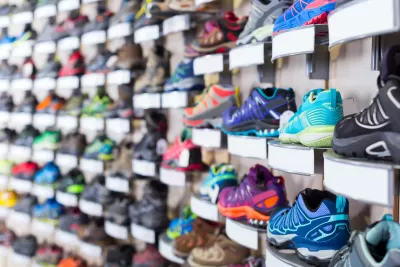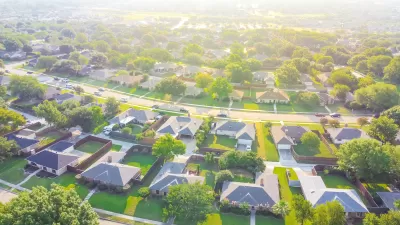What the shoe industry can teach us about the housing crisis.

In an excerpt from their upcoming book, Escaping the Housing Trap: The Strong Towns Response to the Housing Crisis, Charles Marohn and Daniel Herriges claim that “If We Made Shoes Like We Make Housing, People Would Go Barefoot.”
To illustrate their point, the authors write, “Imagine a shoe market that produces only two kinds of shoes: a high-end loafer and an elite-brand tennis shoe.” Companies and governments incentivize the production of just two types of shoe, and “Local permitting restricts the number of shoes that can be made. Rising prices have bloated supply chains, making everything more expensive. The extensive web of public and private capital vested in producing high-end loafers and elite-brand tennis shoes stifles innovation.”
In this world, “Lots of people who want shoes can’t get them. They go barefoot. Those who can buy shoes feel financially squeezed. Price increases are normalized, even expected. Many people are desperate to get any pair of shoes.”
This scenario seems unrealistic—for shoes. “Yet our present housing crisis, which seems normal to us, would be absurd to anyone living a century ago. In the context of millennia of human development, we are the first culture to find ourselves with a chronic shortage of housing.”
For the authors, the answer is clear: “We wiped out the starter rung on the ladder. We need a housing market that produces penny loafers again.”
FULL STORY: If We Made Shoes Like We Make Housing, People Would Go Barefoot

Study: Maui’s Plan to Convert Vacation Rentals to Long-Term Housing Could Cause Nearly $1 Billion Economic Loss
The plan would reduce visitor accommodation by 25,% resulting in 1,900 jobs lost.

Alabama: Trump Terminates Settlements for Black Communities Harmed By Raw Sewage
Trump deemed the landmark civil rights agreement “illegal DEI and environmental justice policy.”

Why Should We Subsidize Public Transportation?
Many public transit agencies face financial stress due to rising costs, declining fare revenue, and declining subsidies. Transit advocates must provide a strong business case for increasing public transit funding.

Paris Bike Boom Leads to Steep Drop in Air Pollution
The French city’s air quality has improved dramatically in the past 20 years, coinciding with a growth in cycling.

Why Housing Costs More to Build in California Than in Texas
Hard costs like labor and materials combined with ‘soft’ costs such as permitting make building in the San Francisco Bay Area almost three times as costly as in Texas cities.

San Diego County Sees a Rise in Urban Coyotes
San Diego County experiences a rise in urban coyotes, as sightings become prevalent throughout its urban neighbourhoods and surrounding areas.
Urban Design for Planners 1: Software Tools
This six-course series explores essential urban design concepts using open source software and equips planners with the tools they need to participate fully in the urban design process.
Planning for Universal Design
Learn the tools for implementing Universal Design in planning regulations.
Smith Gee Studio
Alamo Area Metropolitan Planning Organization
City of Santa Clarita
Institute for Housing and Urban Development Studies (IHS)
City of Grandview
Harvard GSD Executive Education
Toledo-Lucas County Plan Commissions
Salt Lake City
NYU Wagner Graduate School of Public Service




























